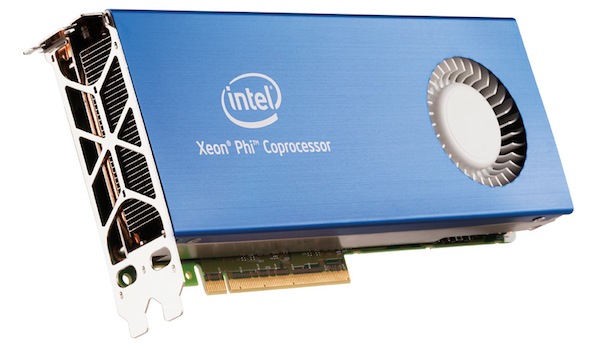Intel Announces Intel Xeon Phi Brand
Products based on Intel Many Integrated Core architecture scheduled for release this year.
Latest News
June 18, 2012
By Jamie J. Gooch
At the International Supercomputing Conference, Intel Corporation announced that Intel Xeon Phi is the new brand name for all future Intel Many Integrated Core Architecture (Intel MIC architecture) based products.

Available by the end of 2012, the first generation of Intel Xeon Phi product family (coprocessors codenamed “Knights Corner”) will complement the existing Intel Xeon processor E5-2600/4600 product families and deliver new levels of performance for highly parallel workloads. While the first generation primarily targets high performance computing (HPC), future generations of Intel Xeon Phi products will also address enterprise datacenters and workstations.
In addition to delivering performance for highly parallel applications, Intel says its Xeon Phi coprocessor’s ease of use is bolstered by the benefits of familiar programming models, techniques and developer tools available with Intel architecture. With greater use of parallel CPU code, software companies and IT departments do not have to retrain developers on proprietary programming models associated with accelerators.
Beyond its compatibility with x86 programming models, the Intel Xeon Phi coprocessor will be visible to applications as an HPC-optimized, highly-parallel, separate compute node that runs its own Linux-based operating system independent of the host OS. This feature allows more flexibility when implementing cluster solutions that are not available with alternative graphics accelerator-based technologies, according to the company.
Made with Intel’s innovative 22nm, 3-D tri-gate transistors, the Intel Xeon Phi coprocessor, available in a PCIe form factor, contains more than 50 cores and a minimum of 8GB of GDDR5 memory. It also features 512b wide SIMD support that improves performance by enabling multiple data elements to be processed with a single instruction. Last year Intel showed a live demonstration of the single Knights Corner coprocessor delivering over 1 TeraFLOPs (1 trillion floating point operations per second) of double precision real life performance, as measured by DGEMM. At ISC’12 Intel demonstrated the same performance of more than 1 TeraFLOPs per node but measured by the industry standard benchmark Linpack (Rmax).
While initial production product shipments are planned for the second half of 2012, Intel has announced that the first Intel Xeon Phi coprocessor-based development cluster is up and running and ranked 149th on the Top500 list, delivering 118 TFLOPs of performance.
The Intel Xeon Phi coprocessor has 44 manufacturers—including Bull, Cray, Dell, HP, IBM, Inspur, SGI and NEC—committed to including it in their system roadmaps.
“We are very excited to announce that our next-generation supercomputer code-named ‘Cascade’ will be available with the Intel Xeon Phi coprocessors, giving Cray customers the ability to push the limits of research and discovery,” said Peg Williams, Cray’s senior vice president of high performance computing systems. “Our Cascade system will feature some of the most advanced and highly innovative HPC technologies ever put into a Cray supercomputer. Combining these features with industry-leading Intel Xeon processors and the new Intel Xeon Phi coprocessors will result in a very compelling system for HPC centers around the world.”
Due to power-on in early 2013, the first Petascale class supercomputer powered by a combination of the Intel Xeon processor E5 family and Intel Xeon Phi coprocessors will be “Stampede.” Intel expects a growing number of Petascale-class machines in the next year that take advantage of the Intel Xeon Phi coprocessors’ programmability and performance efficiency.
Intel Xeon’s Place on the Top500
The company also announced that its Intel Xeon processor E5-2600 product family powers 44 systems, including three petascale-class supercomputers on the 39th edition of the Top500 list announced today.
The “SuperMUC” supercomputer at LRZ in Germany, which ranked fourth on the list, delivers 2.9 PetaFLOPs of performance, making it the most powerful in Europe, as well as the largest installation based on the new Intel Xeon processors E5 family.
“The Intel Xeon processor E5 family is powering exponential performance gains in high performance computing and we’re proud that it is having such a profound impact on the industry as demonstrated by its presence inside 44 of the Top500 supercomputers,” said Raj Hazra, Intel Corporation vice president and general manager of the Technical Computing at Data Center and Connected Systems Group. “As we add Intel Xeon Phi products to our portfolio, scientists, engineers and IT professionals will experience breakthrough levels of performance to effectively address challenges ranging from climate change to risk management. This is the next step of Intel’s commitment to achieve exascale-level computation by 2018, and create a unique technology category that delivers unprecedented performance for today’s highly parallel applications.”
More than 74% (372 systems) of the supercomputers on the 39th edition of the Top500 list are powered by Intel processors, according to the company. Of those systems making their first appearance on the list, Intel-powered systems account for more than 77%. The complete report is available at www.top500.org.
For more information, visit Intel.
Sources: Briefing from company representatives, press materials received from the company and additional information gleaned from the company’s website.
Subscribe to our FREE magazine, FREE email newsletters or both!
Latest News
About the Author
Jamie Gooch is the former editorial director of Digital Engineering.
Follow DE





